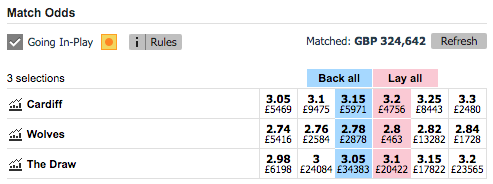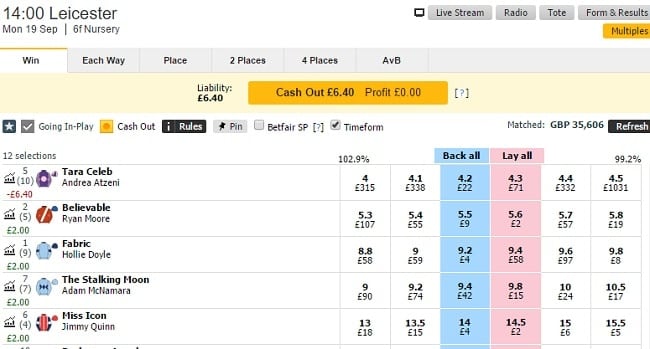Lay Betting Sites
Lay Betting Sites: How Do Betting Exchanges Work? One of the biggest revolutions brought about by the online betting industry is the ability to back against certain results rather than for them. This is known as lay betting, and means you bet that something won’t happen rather than betting that it will. Free Lay Betting Tips Every Day Tuesday 27th February 2019 Tips courtesy of Lay Bet Winners For more free lay betting tips every day click the link above. Here is Today’s free tip 17.10 Southwell – Rusper Dreams – 7.4 (Betfair odds. Lay Betting Systems Provide a number of lay betting systems for horse racing, greyhounds and football. Systems are provided for free, for some you just need to share the link in order to view them, while others you need to enter an email address.
In recent years, online sports betting and betting on horses have drastically changed. With the introduction of betting exchanges like Betfair, a true capitalistic system has been developed for punters all over the world. Before we discuss the lay betting process, it’s really important for anyone who is interested in such action to take the time necessary to under the risks/rewards of lay betting before jumping into the deep end of the pool.
What is Lay Betting?
Most Internet punters bet sports and horses with their favorite betting sites. When they make their bets, they are essentially agreeing to do so at the odds as stated by the online bookmaker. Horse racing fans are either excepting fixed odds or putting their money into a pari-mutual pool. In both cases, they get what they get as far as odds are concerned.
Lay betting offers another option. Should a punter feel they are knowledgeable enough to make their own own lines or odds, they can join one of several betting exchanges. Betting exchanges allow their customers to act as bookies and make their own lines for offer to other customers. The exchanges stake in the entire process is a commission on the lay bettor’s profits (usually 5%).
As lay betting relates to horse racing, the punter is essentially betting on horses to lose. While that may seem easier than picking a winner, it comes with significant risks. The lay bettor’s task is to develop a line on a horse or group of horses at odds they deem as fair. As long as there’s a customer who is willing to accept the prescribe odds for the amount being offered, the wagered can be consummated.
If the target horse loses, the lay bettor collects the amount of the bet minus the exchange’s commission. If the horse wins, the lay bettor has to pay the customer the amount of the bet times the stated odds.
The Pros and Cons of Lay Betting on Horses
The risks related to lay betting should be clear. If the lay bettor offers a horse at high odds and the horse wins, the lay bettor loses a lot of money for the chance to win a smaller portion. That’s not always a wise decision.

The rewards are usually smaller than the inherent risks, but there are wagering advantages for the lay bettor. If they can lay numbers on several horses in the same race, there’s a chance the money collected might exceed any potential payout, regardless of which horse wins. This would be similar to the lay bettor simply collecting commission with no real risks. This is a good alternative for the horse player, who fancies themselves as an astute handicapper.
The Spread Strategy
The advent of betting exchanges has made it possible for punters to play or back bet a horse at fixed odds while laying the horse at lower odds on the exchange. This strategy is always available for astute punters who have the time to track odds. Let’s run through a spread strategy example.
Let’s say on track bookmakers are offering horse A at fixed odds of 10-1. The punter makes a wager at those odds for $100AUS. Now they go to their betting exchange account and play a lay bet on the same horse for the same $100AUS at 9-1. Let’s say a betting exchange custom accepts that wager. The lay bettor has effectively bet the horse to both win and lose. However, they stand to profit with very little risk. How so?
If horse A wins, the punter wins $1,100AUS (the $100AUS amount wagered + the winnings at 10-1) from the bookmaker. On the betting exchange, they pay the back bettor $1,000AUS (the $100AUS wagered + winnings at 9-1). They collect $1,100AUS, pay $1,000AUS for a net profit of $100AUS).
If horse a loses, they lose $100AUS to the bookmaker and collect $95AUS ($100 less 5% commission) on the betting exchange for a net loss of $5AUS.
By using the spread, they risk the $5AUS for a chance to win $100AUS. That’s 20-1 odds on a horse that was listed at 10-1. That creates a significant spread that could be financially rewarding over an extended period of time.
You might wonder why a punter would bet on a horse at 9-1 on the exchange when the same horse is available at 10-1 on track. Well, not everyone can make it to the track and most most bookmakers use pari-mutual pools, which might be offering odds that are less than 9-1. In such cases, settling for the 9-1 makes sense.
Again, lay betting comes with risks. The lay bettor needs to have an understanding of odds and know how to minimize risks in order to show a regular profit.
About the Author: Daryl CurnowAfter graduating from the University of Auckland (BA – English), Daryl was thrown into the world of sports and horse racing journalism.
Having worked as a racing journalist for two years, he decided to move into the online world of horse racing and sports writing. After years of honing his craft, Daryl became a professional punter in 2009 – with a focus on horse racing, NRL, AFL, NBA, Rugby, NFL, and US college sports. Daryl’s tips have been featured on various websites around the world before joining the GoBet team. When he’s not working, Daryl tries to avoid making bogeys on the golf course.
One of the biggest revolutions brought about by the online betting industry is the ability to back against certain results rather than for them. This is known as lay betting, and means you bet that something won’t happen rather than betting that it will.
Until just over a decade ago the only option was to back a result, which has its limitations for bettors.
Betting exchanges are what changed everything, allowing the punter to effectively become the bookmaker, and these are the destination for anyone that wants to lay a bet.
However, there are certain bets in certain markets that offer the same sort of results, which we will discuss throughout this article.
Betting Exchanges List
On the rest of the page we get into the nitty gritty of what a lay betting site is and how it works, but if you’re just after a quick list of sites that offer this kind of bet then see below:
What is Lay Betting?
Lay betting is betting against a result. If you look at any online bookmaker, they are laying every single bet on their site. It is then up to the punter to decide whether they think a certain outcome will happen, and if they do then they can back it.
This means the bookie is in control because they choose the bets and the odds that accompany them. The only choice for the punter is whether to accept them or not.
As a quick example, you might want to back a horse to win a race because you have some great inside info. However, you have searched all of the sites and can’t find a price that you are happy with. In the old days that would be tough luck, take it or leave it.
These days, you have another option. You could decide to lay the bet on a betting exchange instead. Even though you think the horse will win, you can set odds against it winning that are better than the bookies are offering (and therefore more likely to be taken up by another punter), but make sure the odds are still profitable for you.
How do Betting Exchanges Work?
The exchanges have been around since circa 2000 and caused quite a stir at the time, giving the punter more power and really shaking up the industry.
An exchange is different from a bookie because you are betting against other bettors instead of a bookmaker. This is called Peer-To-Peer or P2P betting because you are betting against your peers.

The exchanges make their money by taking a small commission from each bet. For example, you might bet £10 on a horse to win a race at 10.00 (9/1). If you win, the exchange will then take around 5% (at most, some take less) of your winnings in commission. So, for this bet the commission would be 5% of your £90 profit, equalling £4.50.
The same thing happens when you lay a bet and win as you are making a profit on it. You won’t pay any commission on losing bets, so the exchange won’t take two lots of commission as each market can only have one winner. So regardless of whether you back or lay on the exchange, you will only pay if you win.
The beauty of the exchange is that you are able to set your own price, and so long as someone else takes that price your bet is on. This is called a match. You aren’t guaranteed a match, but the majority of markets will turn in-play and your price will be available until the market closes (game or race ends). If it still isn’t taken then your stake will be returned. Un-matched bets are usually down to low value odds or poor footfall in the market.
Your Liability
When you lay a bet on the exchange it’s important to know exactly how it works. Unlike when you back a bet, you aren’t entering a stake with returns based on your odds; with a lay bet the maximum you can win is the stake that you enter and the liability that you could pay out is then based on the odds that you set.
In short, the bet could cost you money, so you need to think about your finances ahead of time.
If you look at the image above, we have bet against Napoli to win at odds of 1.74 with a £10 stake. If Napoli does win, then we pay out the liability for this bet, which in this case is £7.40. If Napoli doesn’t win, then we get the backers stake, so here it would be £10 profit.
Liquidity
The next thing we want to talk about is liquidity. This is basically the amount of money that can be staked at a certain price for that market.

From the image above you can see that there are financial figures shown underneath each of the prices. This is the liquidity for that bet and the maximum amount of money staked for that selection at that price. For example, you can see that to lay Napoli at odds of 1.73 there is £295 left at that price. If we want to bet more, we can then move down to 1.74 where there is currently £3409 available.
Liquidity isn’t a massive factor for high profile sporting events such as Arsenal v Napoli. You can see in the top right of that image that over £132,000 has been matched, which is quite high and will get higher.
Liquidity becomes an issue at lower-profile events where less money is being staked. This can make it more difficult to either get the price that you want to back or get a low price to lay given there is less money kicking about. You will find disparity in liquidity at each betting exchange as well, with Betfair having a significantly higher market share than all of their competitors, and exchanges only work if people use them.
What’s neat about the betting exchanges is that you are going to quickly be able to see what sort of bet you place and how it affects each of the selections in your betting market.

Continuing with our Napoli example, on the left of the image above we can see the profit that we will make on each result signified by the red (loss) and green (profit) numbers. This is handy when deciding how much exposure you want to create when laying your bets. It also works great if you decide to back your bets at a later date to lock in a profit.
Alternative Methods
You don’t necessarily have to use the exchanges to lay a bet, you can get creative using regular betting markets, but it might not always be as profitable as the bookie will have worked in their margins. To do this, we are looking at bets that cover all but one result; a good example would be using the Win and Draw markets in football.
Let’s say that we are still looking to lay a Napoli win against Arsenal. We can use the double chance market to select our bets to cover this.
By selecting Arsenal and Draw we can cover the two other betting options that would go head to head with the Napoli win. As you can see, the price is a little higher for this than laying Napoli straight off, at odds of 2.10 compared with 1.73.
Lay Betting Sites Uk
So, which works out at better value?
If we staked £10 on the Arsenal and Draw bet on the double chance market, our returns would be £21, with £11 of that being profit.
If we laid this bet at odds of 1.74 for £11, which is the profit that we would be getting from the back bet, then we would have an exposure of £8.03 at odds of 1.73.
So, the best bet would be to lay them on the exchange as we are only risking £8.03 compared with £10 using the traditional sportsbook method, for what is essentially the same bet.
Is the Exchange Always Better Value?
The exchange is likely going to give you better odds than most traditional bookmakers would, yes. This is common knowledge throughout the industry, it’s just that some people get a little overwhelmed by the whole process.
Back And Lay Betting Sites
Betting exchanges are actually very simple to use once you get over the learning curve, and they are as transparent in terms of what you need to stake and what might be returned as any traditional bookmaker.
If you are looking to lay bets then the exchange is the way to go. We’ve shown you an example of how you can use a bookmaker to essentially lay a selection, but the opportunities are few and far between, while the exchange offers you the chance to lay thousands of bets every day and at better value, too.
Best Lay Betting Sites
In fact, some of the professional bookmakers even use the likes of Betfair or other betting exchanges to balance their books. For example, if they have too much exposure on a certain bet or market, they will jump into the exchanges to lay or back some of it off to cover their backs.
Lay Betting Sites
If registered bookies are using them then you sure as heck should be too.



